ThruNite Catapult V2



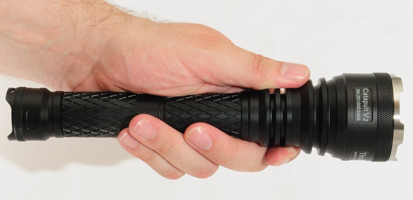
ThruNite started with a small keychain light and then moved on to a big thrower light, this light here is an improved version of the thrower light. The light is supplied as a short light and an extender, but for most uses the only configuration is with the extender. The light has only two brightness settings, controlled with tight/loose head and no flashing settings. The tail switch only controls on/off. With only two levels and no flashing modes, the light does not need a microprocessor, making the driver simpler. The light is made of aluminum with hard-anodized (Type 3) finish.

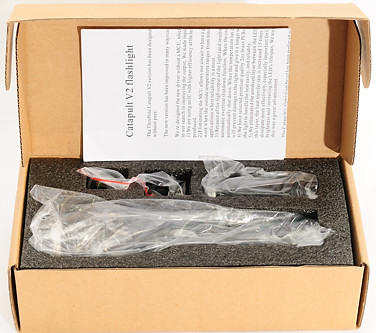
The light arrives in a simple cardboard box.
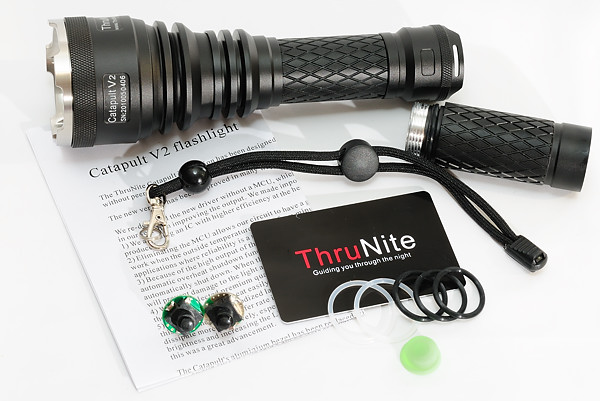
The contents of the box is: flashlight with extension tube, lanyard, 5 spare o-rings, a GITD (Glow in the Dark) boot for the tail switch, manual, warranty/serial number card and 2x spare tail switch.


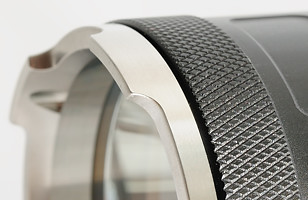
The light has a smooth reflector with a SST-50 led at the bottom. With the stainless steel bezel the front of the light can take a lot of punishment.
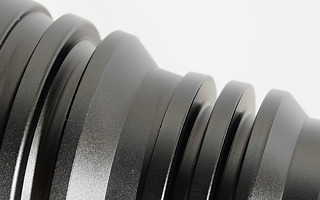
The head has a design with some fins to improve cooling, this is important to get rid of the heat the led generates.
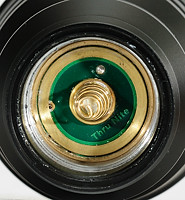
The head connects to the battery with a spring, this makes it possible to use flat top batteries in the light. The golden ring on the circuit board is the switch for high, i.e. when the head is tight the top of the battery tube has connection to the golden ring and the light is in high mode. For low mode power is supplied through the threads.
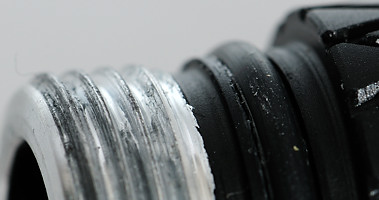
The threads are triangular without anodizing, because they are part of the current path. The light has o-rings at all threads.
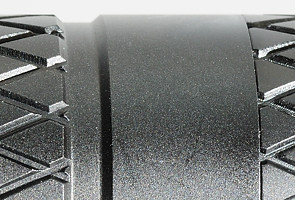
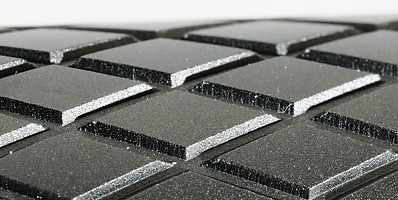
The body of the light consists of a two part battery tube. The connection between the two parts is very nicely done. Except for the connection, the battery tube is covered in a diamond knurling that gives a good grip. Both the head and the tail has a larger diameter than the body, this also reduces the risk of the light sliding out of the hand.
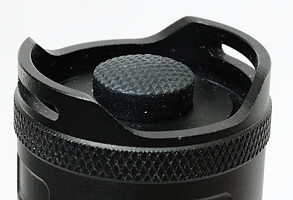
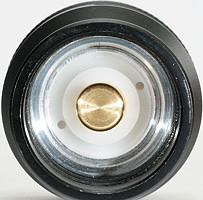
The tail allows tail standing and has holes for mounting the lanyard. The light is mounted with a black rubber boot and has a forward switch under it, i.e. a light press will give momentary light, pressing harder will lock on. In the tail there is a cap over the spring.
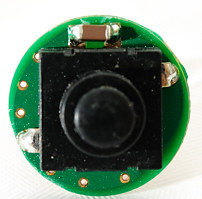
Here is one of the spare tail switches, looking at it there are more than just the switch, there is a small component beside the switch. It is a 10uF capacitor that is wired parallel to the switch. I wonder if this is the reason for two spares, a capacitor mounted directly over a switch will increase the wear on the switch.

Here is all the part the light can be disassembled in without tools. Note that the extender is mounted closest to the head.
I liked the first Catapult and I believe that the V2 is a improvement (Depending on appliation). Moving the brightness selection away from the switch improves the usability of the light for tactical usage, there is no risk of a level change. The stainless steel bezel is also a plus, especially for rough usage.
Technical specification and measurements
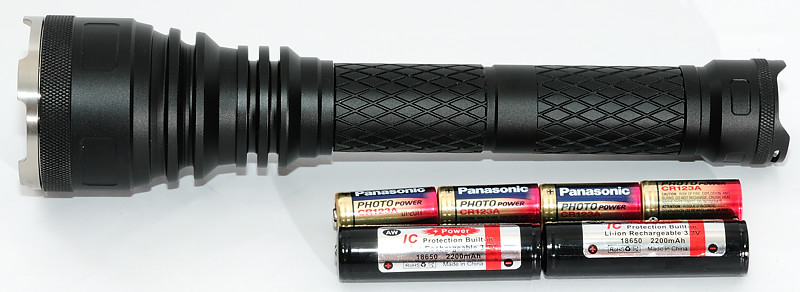
With the extender tube the light can run on either 2x18650 or 4xCR123 batteries, without extender it really need 2x16340 IMR cells (On low it can also use 2xCR123), but this would give a very short runtime. I will restrict my measurements to the full length light.
Measured size and weight:
Length: 256 mm
Diameter: 30 to 59 mm
Weight: 542 gram with 2x18650, 514 gram with 4xCR123
The light uses a Luminus SST-50 led.

In the above table I have both modes with both 18650 and CR123 batteries. The runtime estimate uses 2200mAh for 18650 and 1400mAh for CR123.
The estimated lumen are scale from the specified maximum and shows that low is a higher than specified. The brightness is a relative measurement from a lux meter.
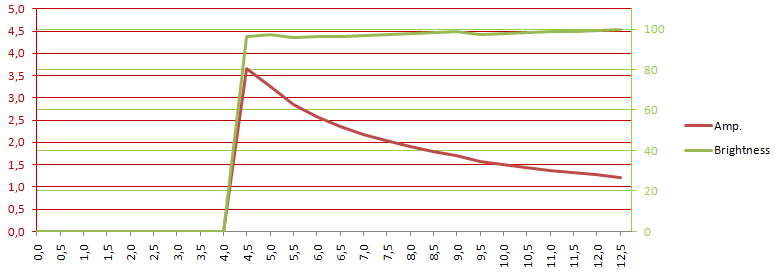
The voltage sweep shows a light with very good stabilizing down to 4.5 volt. The light is using 15 watt in high setting and 3.6 watt in low mode with small variation due to voltage. A interesting observation is that the light uses 3.5 ampere, just before it shuts down, this current is fine for 18650 batteries but on the high side for CR123 batteries.
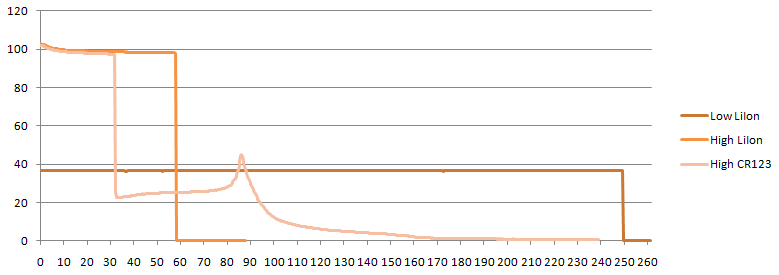
The good stabilization gives a very flat runtime curve, but the CR123 has much shorter runtime than expected. My guess (I do not have instruments connected to the batteries while doing runtime) is that the heavy current drain pulls the battery voltage down to between 4 and 4.5 volt. There the brightness goes down because the light is just on the edge of shutting down, but when the current drain goes down, the voltage raises again, this will also explain some flickering I saw in the light at this stage.
The light is supposed to have a build in temperature sensor that will shut the light down if it get to hot. To test it I placed the light on a table with fresh 18650 batteries, after 1 hour the temperature of the light was increased with 43 degree centigrade without the light shutting down. The temperature on the outside of the head was 68 degree centigrade and the light is first supposed to shut down at 120 degree (inside). I suppose it was not hot enough to shut down. I.e. the light has sufficient cooling.
There are no curves of the light to show, the light has no flashing modes and no pwm.
Comparison to other Flashlights
JetBeam M2S, Jetbeam RRT-3, Fenix TK40
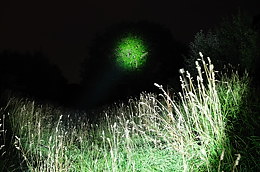
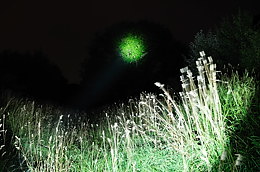
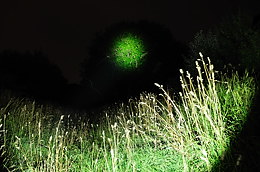
Fenix TK45, ThruNite Catapult, ThruNite Catapult V2

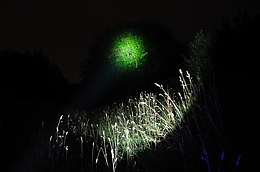
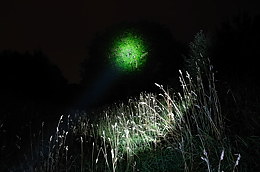
For the full comparison to other lights with graphs and beamshots see here.
Notes
The light was supplied by ThruNite for a review.




























